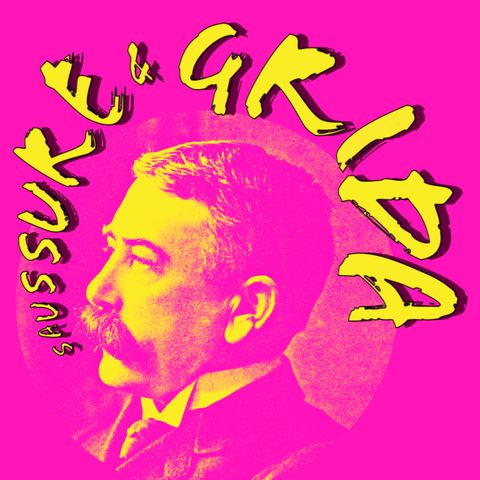14. La lingua cambia il modo di percepire il mondo? L'ipotesi di Sapir-Whorf e la relatività linguistica

Download and listen anywhere
Download your favorite episodes and enjoy them, wherever you are! Sign up or log in now to access offline listening.
Description
Questo episodio esplora l'ipotesi di Sapir-Whorf e la relatività linguistica, concentrandosi sul modo in cui le lingue possono influenzare la nostra percezione e comprensione del mondo. Oggi parliamo della storia...
show moreGrafiche: Gianluca La Bruna
La sigla è stata prodotta da White Hot e fornita da https://freebeats.io
FONTI:
- Barsalou, L. (2008). Grounded cognition. Annual Review of Psychology, 59, 617–645.
- Belacchi, C., & Cubelli, R. (2012). Implicit knowledge of grammatical gender in preschool children. Journal of Psycholinguistic Research, 41:295–310.
- Berlin, B. & Kay, P. (1969). Basic color terms: Their universality and evolution. Berkeley: University of California Press.
- Boas, Franz (1889). On Alternating Sounds. American Anthropologist. 2(1):47–54.
- Boroditsky, L., & Schmidt, L.A. (2000). Sex, syntax, and semantics. In L.R. Gleitman & A.K. Joshi (Eds.), Proceedings of the Twenty-Second Annual Conference of the Cognitive Science Society (:42–46). Mahwah, NJ: Erlbaum.
- Brown, A., Lindsey, D.T., & Guckes, K.M. (2011). Color names, color categories, and color-cued visual search: Sometimes, color perception is not categorical. Journal of Vision, 11-12(2):1–21.
- Carroll, J.B. (Ed.) (1956). Language, thought, and reality: Selected writings of Benjamin Lee Whorf. Cambridge & Massachusetts: Technology Press of Massachusetts.
- Cichocki, P., & Kilarski, M. (2010). On "Eskimo Words for Snow": The life cycle of a linguistic misconception. Historiographia Linguistica, 37(3):341–377.
- Code, L. (1980). Language and knowledge. Word, 31(3):245-258.
- Darnell, R. (1990). Edward Sapir: linguist, anthropologist, humanist. University of California Press.
- Fortescue, M.D., Jacobson, S., & Kaplan, L. (Eds.) (2010). Comparative Eskimo Dictionary: With Aleut Cognates (2nd ed.). Alaska Native Language Center, University of Alaska Fairbanks.
- Gleitman, L., & Papafragou, A. (2013). Relations between language and thought. In D. Reisberg (Ed.), The Oxford handbook of cognitive psychology (:504–523). New York, NY: Oxford University Press.
- Humboldt von, W.C. (1836)[1988]. On Language: The Diversity of Human Language Structure and its influence on the Mental Development of Mankind. Cambridge, UK: Cambridge University Press.
- Kay, P., & Regier, T. (2006). Language, thought and color: recent developments. Trends in cognitive sciences, 10(2):51-54.
- Krupnik, I., & Müller-Wille, L. (2010). Franz Boas and Inuktitut Terminology for Ice and Snow: From the Emergence of the Field to the "Great Eskimo Vocabulary Hoax". In I. Krupnik, C. Aporta, S. Gearheard, & G. Laidler (Eds.) SIKU: Knowing Our Ice (:377-400). Dordrecht, NL: Springer Netherlands.
- Kurinski, E., Jambor, E., & Sera, M.D. (2016). Spanish grammatical gender: its effects on categorization in native Hungarian speakers. International Journal of Bilingualism, 20:76–93.
- Lenneberg, E., & Roberts, J. (1953). The denotation of color terms. Paper presented to the Linguistic Society of America, Bloomington.
- Matallo, H.J. (2023). Relativistic Language and the Natural Philosophy Big-Bang. Manuscript. PhilArchive.org
- Phillips, W., & Boroditsky, L. (2003). Can quirks of grammar affect the way you think? Grammatical gender and object concepts. Paper presented at the 25th Annual Meeting of the Cognitive Science Society, Boston, MA.
- Pinker, S. (1994). The Language Instinct. New York: HarperCollins.
- Platone, Fedro (2012). P. Pucci, & B.Centrone (Eds.), Roma- Bari: Laterza.
- Pourcel S. ( 2002). Investigating linguistic relativity: A research methodology. Durham Working Papers in Linguistics, 8:125-38.
- Pulvermuller, F. (1999). Words in the brain's language. Behavioral and Brain Sciences, 22:253–279.
- Roberson, D., Pak, H., & Hanley, J. R. (2008). Categorical perception of colour in the left and right visual field is verbally mediated: Evidence from Korean. Cognition, 107:752–762.
- Sapir, E. (1924). The grammarian and his language. The American Mercury, (1):149–155.
- Sapir, E. (1929). A study in phonetic symbolism. Journal of Experimental Psychology, 12(3), 225–239
- Sapir, E. (1933). La réalité psychologique des phonèmes. Journal de Psychologie Normale et Pathologique, 30:247–265.
- Sato, S., & Athanasopoulos, P. (2018). Grammatical gender affects gender perception: Evidence for the structural-feedback hypothesis. Cognition, 176:220–231.
- Scovel, T. (1991). Why languages do not shape cognition: Psycho- and neurolinguistic evidence. JALT (Japan Association for Language Teaching) Journal, 13(1):43-56.
- Taylor, I. (1976). Introduction to psycholinguistics. New York: Holt, Rinehart and Winston.
- Thierry G. (2016). Neurolinguistic Relativity: How Language Flexes Human Perception and Cognition. Language learning, 66(3):690–713.
- Trabant, J. (2017) Wilhelm von Humboldt linguista. In: A. Carrano, E. Massimilla, & F. Tessitore (Eds.) Wilhelm von Humboldt, duecentocinquant’anni dopo. Incontri e confronti (:1-21). Napoli: Liguori.
Information
| Author | Irene |
| Organization | Irene Lami |
| Website | - |
| Tags |
Copyright 2024 - Spreaker Inc. an iHeartMedia Company

Comments